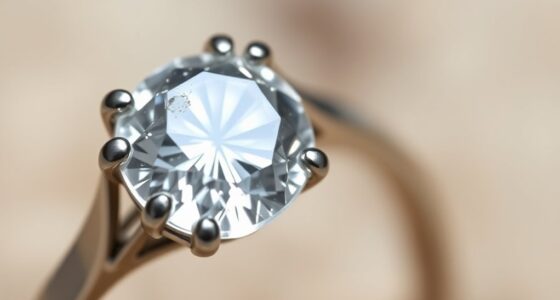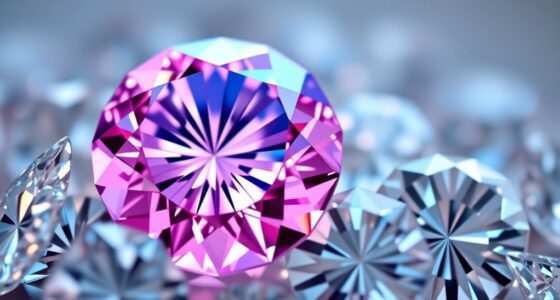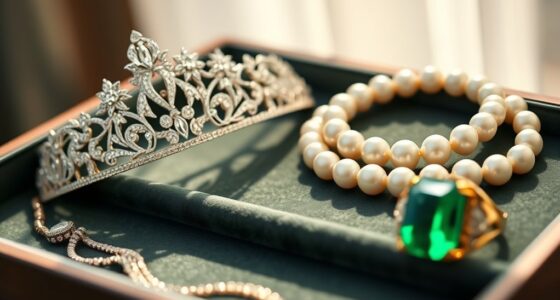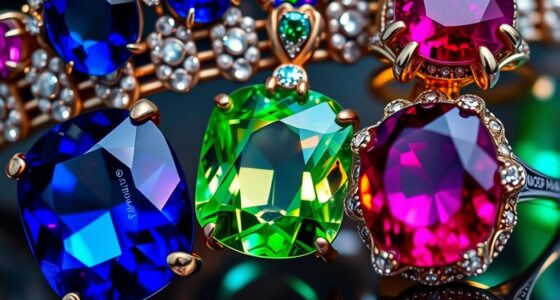Men’s jewelry is quickly becoming a major driver in the luxury market, thanks to shifting cultural norms, increased focus on personal style, and digital innovation. As more men embrace jewelry for everyday wear, designers are creating versatile, modern pieces using materials like gold and diamonds. With rising demand globally—especially in Asia—and a surge in online shopping and influencer influence, this sector is poised for rapid growth. Keep exploring to discover what’s fueling this exciting trend.
Key Takeaways
- The global men’s jewelry market is projected to grow from $9 billion in 2024 to over $14 billion by 2034.
- Changing cultural norms and fashion trends are positioning jewelry as a key form of personal expression for men.
- Innovations in design and materials, like mixed metals and luxury finishes, are appealing to modern male consumers.
- E-commerce platforms and digital technologies facilitate wider access and engagement with men’s luxury jewelry.
- Asia Pacific dominates the market, highlighting regional growth and increasing global demand for men’s luxury jewelry.
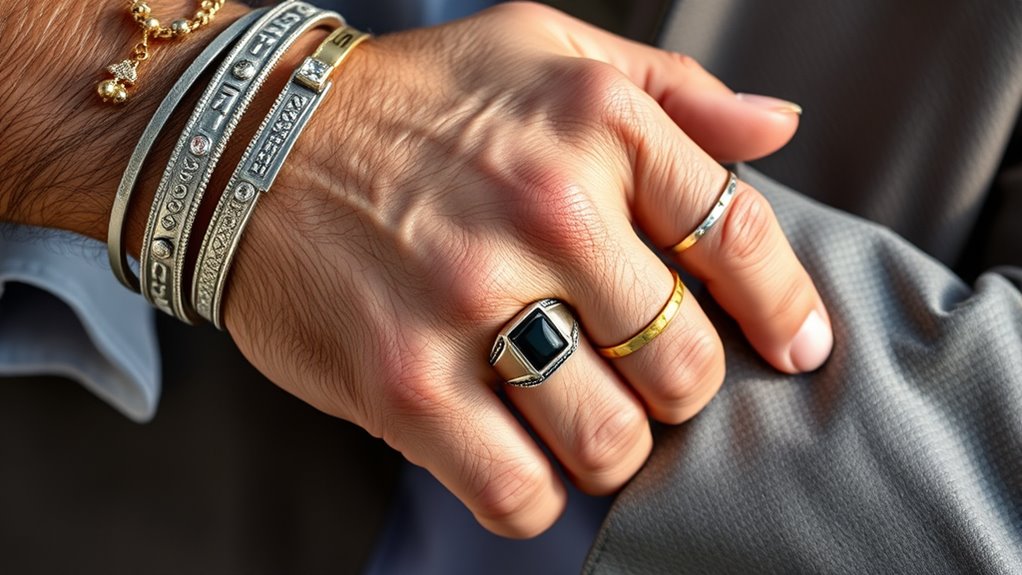
As the global luxury jewelry market continues to expand, men’s jewelry is emerging as the next significant growth sector. Valued at around $9 billion in 2024, this segment is projected to surpass $14 billion by 2034, growing at an annual rate of 5-8%. The U.S. alone accounts for over half of this, with a market size of $5.64 billion in 2024 and an expected CAGR of 8.4% through 2034. This rising demand reflects a broader shift in consumer preferences, fueled by changing cultural norms and increased fashion consciousness. You’re increasingly likely to see men accessorizing as part of their daily wardrobe, not just for special occasions. Jewelry is now viewed as a form of personal expression, and brands are shifting their marketing strategies to emphasize individuality, metrosexuality, and gender fluidity. This cultural transformation broadens the appeal of men’s jewelry, making it more inclusive and versatile. Market size and growth projections The trend towards mindful consumption resonates with consumers as they seek jewelry that reflects their values. Social media platforms and influencer culture play a pivotal role in shaping consumer behavior. Younger men, in particular, are more open to experimenting with jewelry such as rings, bracelets, necklaces, and earrings. Bracelets are experiencing rapid growth, rivaling traditional staples like watches and cufflinks, thanks to their versatility and style options. Gold remains the preferred material, appreciated for its luxury appeal, design flexibility, and status symbolism. Meanwhile, innovations in design incorporate masculine aesthetics with luxury finishes, including diamond accents and mixed metals, appealing to modern tastes. Sustainability also influences purchasing decisions, with more men seeking ethically sourced and eco-friendly materials, fostering brand loyalty among conscious consumers. The digital landscape accelerates the growth of men’s jewelry by providing convenient access and personalized shopping experiences. E-commerce platforms enable consumers to browse a wider variety of styles and discover niche brands that target men’s luxury jewelry. Direct-to-consumer brands thrive by offering curated, trendy pieces online, making it easier for men to find jewelry that matches their style. Mobile commerce adoption among Millennials and Gen Z further boosts online engagement, leading to increased repeat purchases. Social media marketing and influencer endorsements facilitate rapid trend dissemination and consumer education, making men’s jewelry more visible and desirable. Technologies like virtual try-on and augmented reality apps enhance confidence in purchasing decisions by allowing you to virtually see how pieces look before buying. Regionally, Asia Pacific dominates the luxury jewelry scene, accounting for approximately 66.6% of sales. This regional strength influences global trends and highlights the growing importance of men’s jewelry in emerging markets. As you observe the market’s evolution, it’s clear that men’s jewelry isn’t just a passing trend — it’s becoming a core element of luxury jewelry’s future, driven by shifting consumer behaviors, technological advances, and regional growth dynamics.
Frequently Asked Questions
How Does Men’s Jewelry Influence Overall Fashion Trends?
Men’s jewelry influences overall fashion trends by encouraging more expressive and personalized styles. You’re likely to see layering bracelets, rings, and necklaces, blending traditional and modern looks. It challenges old norms, making jewelry a versatile accessory for men. Influenced by pop culture and social media, you’re inspired to experiment with textures, materials, and statement pieces, which broadens fashion choices and fosters a more inclusive, sophisticated approach to men’s style.
What Materials Are Most Popular in Men’s Luxury Jewelry?
You’ll notice that gold remains the top choice in men’s luxury jewelry, with about 60% of buyers favoring it for its classic appeal. Silver, especially sterling silver, offers affordability and versatility, while platinum is gaining popularity for its durability and premium feel. You’ll also see a rise in recycled metals and ethically sourced gemstones, reflecting a growing preference for sustainable and eco-conscious materials.
How Do Cultural Differences Affect Men’s Jewelry Preferences?
Cultural differences greatly influence your men’s jewelry preferences. If you’re in Africa, you might favor beaded necklaces or earrings that signify heritage and social status. In Asia, jade ornaments or symbolic earrings reflect religious and cultural meanings. Middle Eastern styles often include rings and bracelets representing wealth and family ties. Western trends are shifting toward self-expression with diverse, gender-neutral pieces, influenced by celebrity and social media, encouraging you to explore jewelry that resonates with your cultural roots and personal identity.
What Price Range Defines Luxury Men’s Jewelry?
You might think luxury men’s jewelry starts at eye-watering prices, but it’s generally defined as pieces costing over $1,000. This includes high-end items crafted from precious metals like gold and platinum, often with diamonds or rare gemstones. The price range stretches from just above $1,000 into the tens of thousands for limited-edition or bespoke designs. This segment targets affluent buyers seeking exclusivity, craftsmanship, and status symbols.
How Is Men’s Jewelry Marketing Evolving in the Luxury Sector?
You see men’s jewelry marketing evolving through bold, statement-driven campaigns that emphasize personality and confidence. Brands focus on personalization and customization, creating emotional connections with unique engravings and bespoke designs. Sustainability plays a key role, highlighting eco-friendly materials and responsible sourcing. Visuals showcase layered, versatile styles using mixed metals, appealing to modern masculinity. Influencers and storytelling reinforce jewelry as a symbol of identity, lifestyle, and exclusivity in the luxury market.
Conclusion
Don’t think men’s jewelry is just a passing trend. As luxury brands embrace this shift, you’ll find more options that suit your style and personality. It’s not about following trends blindly but expressing yourself confidently. So, if you’re hesitant, remember—luxury is about individuality, and men’s jewelry is the perfect way to showcase that. Embrace this next big thing, and let your accessories speak volumes about who you are.



